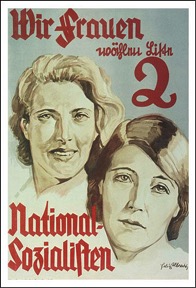National Socialist Women’s League (Nationalsozialistische Frauenschaft, NSF) (1933-1945)
“For her world is her husband, her family, her children, and her home.” – NSF
The National Socialist Women’s League (Nationalsozialistische Frauenschaft, NSF), founded in October 1931, was the women’s wing of the Nazi Party. The association was originally tasked with recruiting a female Nazi elite, but once the Nazi’s came into power in January 1933 it became a mass organization of 2.3 million members, led by Gertrud Scholtz-Klink (1902-1999). She was the Reichsfrauenführerin (the leader of the German women), who had control over all Nazi women’s organizations from 1933 to 1945.
According to historian Ann T. Allen, Nazi ideology held a traditional, conservative view of women that “stressed motherhood, domesticity, and feminine characteristics.” In one of his earliest speeches to Nazi women in 1933, Nazi leader Adolf Hitler stated that women were only useful as “breeders of the superior, Aryan race.” Nazi ideology emphasized motherhood as the most important role of German women to ensure a successful future nation. The Nazi government responded to falling birth rates that threatened military readiness by offering “marriage loans” to encourage newly married Aryan couples to have children. Although this provision was later removed, these loans reiterated Nazi ideology by requiring these women to give up their jobs, and portions of the loans were also forgiven with every child that the couple had. The Nazi regime utilized its women’s organizations as well to implement the importance of women’s roles as mothers.
On September 8, 1934, Hitler gave another speech to the National Socialist Women’s League. His choice of words reiterates that the role of women is to give birth to future soldiers. Hitler stated, “The woman gives in eternal self-sacrifice, in eternal pain and suffering.” As men fought and defended the nation on the battlefield, Hitler expected women to lay down their lives in similar fashion, but through childbirth. He stated, “Every child that a woman brings into the world is a battle, a battle waged for the existence of her people.” Although Nazi ideology emphasized separate gender spheres and saw women as inferior to men, women had an important role in the survival of her nation. Hitler and the Nazi Party employed the use of women organizations like the NSF to ensure that the Third Reich would not fall prey to its opponents.
Under Scholtz-Klink’s leadership, the National Socialist Women’s League implemented a system of mother schools and courses to train girls and young women for motherhood by teaching them such skills as cooking, home economics, sanitation, maternal health, and child-care. Scholtz-Klink informed German women that, “Our weapon is the soup ladle, but let no one underrate its efficacy.” According to Allen, “by 1944, about 5 million girls and women had attended lessons on child-rearing, and about one million had taken cooking courses.” The NSF implemented a mass system of programs that further spread the Nazi ideology of motherhood into the everyday lives of German women and that were vital in supporting the Third Reich.
Scholtz-Klink’s position as the leader of the NSF gave her complete control over propaganda related to German women. No newspaper or magazine was allowed to print any article not approved by the NS Frauenschaft. The National Socialist Women’s League published a women’s magazine, called NS Frauenwarte with a bi-weekly print-run of approximately one million copies in 1938. The main purpose of this magazine was to highlight the importance of women’s service in social and cultural spheres as well as in the family. The NSF’s use of propaganda and implementation of educational programs for motherhood helped the Nazi regime to establish separate spheres for men and women and reinforce traditional gender roles. This changed, however, during World War II, when women, including mothers, were more and more needed by the Third Reich to replace the conscripted men in the war industries and agriculture, as well as many other sectors of the war economy. Nazi ideology and propaganda and the everyday experience of women in wartime increasingly contradicted each other
From 1933 to 1945, the National Socialist Women’s League attempted to gain complete control over Aryan German women. Female Nazi leaders like Gertrud Scholtz-Klink helped with their work to integrate these women in the Third Reich and made the Second World War, the terror of the Nazi regime and the Holocaust possible.
Kayla Travis, Exercise and Sports Science major and History minor, Class of 2018
Sources
Literature and Websites
- Allen, Ann T. Women in Twentieth-Century Europe, 42-59. Basingstoke and New York: Palgrave MacMillan, 2007.
- Noakes, Jeremy and Geoffrey Pridham, eds. Nazism, 1919-1945. Exeter: University of Exeter Press, 2000.
- Pine, Lisa. Nazi Family Policy, 1933-1945. London: Routledge, 1997.
- Stephenson, Jill. Women in Nazi Germany. Oxford: Berg, 2001.
- Teichmann, Jennifer S. “A Triumvirate of Women in the Third Reich: Leni Riefenstahl, Gertrud Scholtz-Klink, and Winifred Wagner.” PhD diss., Central Missouri State University, 1999.
Images






